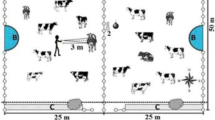Abstract
Body surface temperature can be used to evaluate thermal equilibrium in animals. The bodies of broiler chickens, like those of all birds, are partially covered by feathers. Thus, the heat flow at the boundary layer between broilers’ bodies and the environment differs between feathered and featherless areas. The aim of this investigation was to use linear regression models incorporating environmental parameters and age to predict the surface temperatures of the feathered and featherless areas of broiler chickens. The trial was conducted in a climate chamber, and 576 broilers were distributed in two groups. In the first trial, 288 broilers were monitored after exposure to comfortable or stressful conditions during a 6-week rearing period. Another 288 broilers were measured under the same conditions to test the predictive power of the models. Sensible heat flow was calculated, and for the regions covered by feathers, sensible heat flow was predicted based on the estimated surface temperatures. The surface temperatures of the feathered and featherless areas can be predicted based on air, black globe or operative temperatures. According to the sensible heat flow model, the broilers’ ability to maintain thermal equilibrium by convection and radiation decreased during the rearing period. Sensible heat flow estimated based on estimated surface temperatures can be used to predict animal responses to comfortable and stressful conditions.




Similar content being viewed by others
References
Aerts JM, Berckmans D (2004) A virtual chick for climate control design: static and dynamic simulations of heat losses. Trans ASAE 47:1765–1772
Cangar O, Aerts JM, Buyse J, Berckmans D (2008) Quantification of the spatial distribution of surface temperatures of broilers. Poult Sci 87:2493–2499. doi:10.3382/ps.2007-00326
Cooper MA, Washburn KW (1998) The relationships of body temperature to weight gain, feed consumption, and feed utilization in broilers under heat stress. Poult Sci 77:237–242
Dozier WA, Lott BD, Branton SL (2005) Live performance of male broilers subjected to constant or increasing air velocities at moderate temperatures with a high dew point. Poult Sci 84:1328–1331
Giloh M, Shinder D, Yahav S (2012) Skin surface temperature of broiler chickens is correlated to body core temperature and is indicative of their thermoregulatory status. Poult Sci 91:175–188. doi:10.3382/ps.2011-01497
Horowitz M (1998) Do cellular heat acclimation response modulate central thermoregulatory activity? News Physiol Sci 13:218–225
Kobayashi K, Salam M (2000) Comparing simulated and measured values using mean squared deviation and its components. Agron J 92:345–352
Lin H, Zhang HF, Du R, Gu XH, Zhang ZY, Buyse J, Decuypere E (2005) Thermoregulations responses of broiler chickens to humidity at different ambient temperatures. II. Four weeks of age. Poult Sci 84:1173–1178
Maia ASC, Silva RG, Loureiro CMB (2005) Sensible and latent heat loss from the body surface of Holstein cows in a tropical environment. Int J Biometeorol 50:17–22. doi:10.1007/s00484-005-0267-1
Malheiros RD, Moraes VMB, Bruno LDG, Malheiros EB, Furlan RL, Macari M (2000) Environmental temperature and cloacal and surface temperatures of broiler chicks in first week post-hatch. Appl Poult Sci 9:111–117. http://japr.fass.org/content/9/1/111.full.pdf. Accessed 7 November 2012
Mickelberry WC, Rogler JC, Stadelman WJ (1966) The influence of dietary fat and environmental temperature upon chick growth and carcass composition. Poult Sci 45:313–321
Mitchell HH (1930) The surface area of single comb white leghorn chickens. J Nutr 2:437–449
Moraes VMB, Malheiros RD, Bruggeman V, Collin A, Tona K, Van As P, Onagbesan OM, Buyse J, Decuypere E, Macari M (2003) Effect of thermal conditioning during embryonic development on aspects of physiological responses of broilers to heat stress. J Therm Biol 28:133–140
Nääs IA, Romanini CEB, Neves DP, Nascimento GR, Vercellino RA (2010) Broiler surface temperature of 42 day old chickens. Sci Agric 67:497–502
Nascimento GR, Nääs IA, Pereira DF, Baracho MS, Garcia R (2011) Assessment of broiler surface temperature variation when exposed to different air temperatures. Rev Bras Cienc Avic 13:259–263
Nascimento ST, Silva IJO, Mourão GB, Castro AC (2012) Bands of respiratory rate and cloacal temperature for different broiler chicken strains. Rev Bras Zootec 41:318–1324
Richards SA (1970) The role of hypothalamic temperature in the control of panting in the chicken exposed to heat. J Physiol 211:341–348
Richards SA (1971) The significance of changes in the temperature of the skin and body core of the chicken in the regulation of heat loss. J Physiol 216:1–10
Richards SA (1973) Temperature regulation. Wykeham, London
SAS Institute (2009) User’s guide: statistics, 2nd edn. SAS Institute, Cary
Shinder D, Rusal M, Tanny J, Druyan S, Yahav S (2007) Thermoregulatory responses of chicks (Gallus domesticus) to low ambient temperatures at an early age. Poult Sci 86:2200–2209
Steketee J (1973) Spectral emissivity of skin and pericardium. Phys Med Biol 18:686–696
Tzschentke B (2007) Attainment of thermoregulation as affected by environmental factors. Poult Sci 86:1025–1036
Wathes CM, Clark JA (1981) Sensible heat transfer from the fowl: boundary-layer resistance of a modern fowl. Br Poult Sci 22:161–173
Yahav S, Straschnow A, Luger D, Shinder D, Tanny J, Cohen S (2004) Ventilation, sensible heat loss, broiler energy and water balance under harsh environmental conditions. Poult Sci 83:253–258
Yahav S, Shinder D, Tanny J, Cohen S (2005) Sensible heat loss: the broiler’s paradox. World’s Poult Sci J 61:420–434. doi:10.1079/wps200453
Yahav S, Shinder D, Ruzal M, Giloh M, Piestum Y (2009) Controlling body temperature—the opportunities for highly productive domestic fowl. In: Cisneros AB, Gions BL (eds) Body temperature regulation. Nova Science, New York, pp 65–98
Yanagi T Jr, Xin H, Gates RS (2001) Modeling partial surface evaporative cooling of chickens. ASAE Annual International Meeting, paper no. 01–3011, pp 1–16
Acknowledgment
The authors gratefully acknowledge the financial support of the Brazilian Coordination for the Improvement of Higher Educational Personnel (CAPES).
Author information
Authors and Affiliations
Corresponding author
Rights and permissions
About this article
Cite this article
Nascimento, S.T., da Silva, I.J.O., Maia, A.S.C. et al. Mean surface temperature prediction models for broiler chickens—a study of sensible heat flow. Int J Biometeorol 58, 195–201 (2014). https://doi.org/10.1007/s00484-013-0702-7
Received:
Revised:
Accepted:
Published:
Issue Date:
DOI: https://doi.org/10.1007/s00484-013-0702-7




